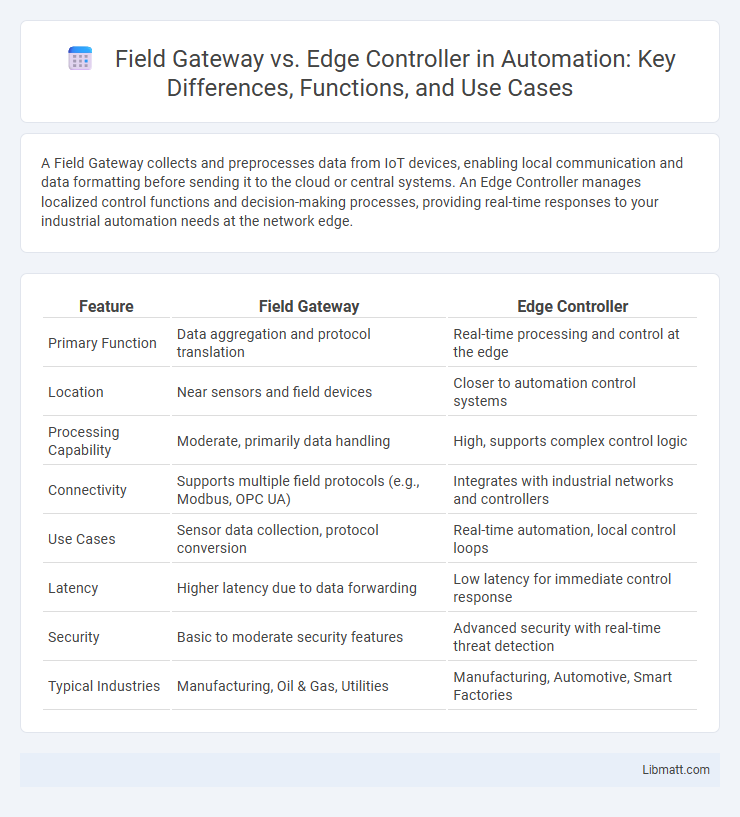A Field Gateway collects and preprocesses data from IoT devices, enabling local communication and data formatting before sending it to the cloud or central systems. An Edge Controller manages localized control functions and decision-making processes, providing real-time responses to your industrial automation needs at the network edge.
Table of Comparison
| Feature | Field Gateway | Edge Controller |
|---|---|---|
| Primary Function | Data aggregation and protocol translation | Real-time processing and control at the edge |
| Location | Near sensors and field devices | Closer to automation control systems |
| Processing Capability | Moderate, primarily data handling | High, supports complex control logic |
| Connectivity | Supports multiple field protocols (e.g., Modbus, OPC UA) | Integrates with industrial networks and controllers |
| Use Cases | Sensor data collection, protocol conversion | Real-time automation, local control loops |
| Latency | Higher latency due to data forwarding | Low latency for immediate control response |
| Security | Basic to moderate security features | Advanced security with real-time threat detection |
| Typical Industries | Manufacturing, Oil & Gas, Utilities | Manufacturing, Automotive, Smart Factories |
Introduction to Field Gateways and Edge Controllers
Field gateways serve as localized data aggregators and protocol translators in industrial IoT environments, facilitating communication between field devices and cloud or central systems. Edge controllers, positioned closer to the physical processes, provide real-time processing, control, and analytics capabilities, enabling faster decision-making at the network edge. Both play critical roles in enhancing connectivity and operational efficiency within smart manufacturing and automation ecosystems.
Key Definitions and Core Functions
Field Gateways serve as intermediaries that collect and preprocess data from various sensors and devices before transmitting it to central systems, optimizing data flow and reducing latency. Edge Controllers manage local processing and control tasks directly at the network edge, enabling real-time decision-making and automation without relying solely on cloud resources. Understanding the difference between these devices helps you design efficient IoT architectures by balancing data handling and immediate control functions.
Architecture Overview: How They Work
Field Gateway acts as an intermediary device that aggregates and preprocesses data from multiple sensors and field devices within Industrial IoT environments, often using protocols like Modbus, OPC-UA, or MQTT. Edge Controller functions as a more advanced processing unit located closer to the data source, enabling real-time analytics, control, and decision-making at the network edge. Your choice between a Field Gateway and Edge Controller depends on the need for local data processing power and integration complexity within your automation architecture.
Data Processing Capabilities
Field Gateways primarily handle data aggregation and protocol translation at the edge, supporting basic preprocessing to reduce the volume of data sent to central systems. Edge Controllers offer more advanced data processing capabilities, including real-time analytics, machine learning inference, and complex event processing directly at the device level. Your selection between the two depends on the required processing intensity and latency sensitivity for your industrial IoT applications.
Connectivity and Protocol Support
Field Gateways offer robust connectivity options for legacy industrial devices, supporting protocols such as Modbus, OPC UA, and PROFIBUS to bridge older equipment with modern IT systems. Edge Controllers provide advanced protocol support including MQTT, OPC UA, and REST APIs, enabling real-time data processing and integration with cloud platforms at the edge. Both devices optimize industrial communication but differ in scope; Field Gateways primarily facilitate protocol translation and device interoperability, while Edge Controllers focus on higher-level processing and broader protocol versatility.
Security Features and Management
Field Gateways offer robust security features including data encryption, device authentication, and secure communication protocols to protect sensitive IoT data at the network edge. Edge Controllers provide enhanced management capabilities with centralized control, automated updates, and real-time monitoring to ensure consistent security policies across distributed devices. Both devices prioritize secure access and threat detection, but Edge Controllers are designed for scalable management in complex industrial environments.
Scalability and Deployment Scenarios
Field Gateways offer high scalability for distributed IoT systems by aggregating data from numerous sensors and devices across wide geographic areas, making them ideal for large-scale industrial or smart city deployments. Edge Controllers provide robust local processing power and control functionalities, suitable for scenarios requiring real-time decision-making and low-latency responses within localized environments such as manufacturing plants or autonomous vehicles. Deployment scenarios favor Field Gateways in hierarchically distributed networks where data consolidation and protocol translation are essential, while Edge Controllers excel in environments demanding immediate analytics and device management at the network edge.
Real-Time Control and Automation
Field Gateway provides data aggregation and protocol translation but lacks advanced real-time control capabilities, making it suitable for monitoring and data collection at the network edge. Edge Controller offers robust real-time control and automation, enabling immediate decision-making and local execution of control algorithms essential for time-sensitive industrial processes. Your automation strategy benefits from Edge Controller's ability to reduce latency and enhance responsiveness in mission-critical applications.
Use Cases Across Industries
Field Gateways are crucial in industries like manufacturing and oil & gas, where they aggregate data from various sensors to enable real-time monitoring and control at the local level. Edge Controllers are heavily utilized in smart cities and autonomous vehicles for processing complex data streams with low latency to support decision-making on-site. Both devices enhance industrial IoT applications by improving connectivity and reducing data transfer to central cloud systems, but Field Gateways excel in data collection while Edge Controllers focus on local computation.
Choosing Between Field Gateway and Edge Controller
Choosing between a Field Gateway and an Edge Controller depends on your specific industrial IoT architecture and data processing needs. Field Gateways excel in aggregating and securely transmitting data from multiple devices to the cloud, ideal for scenarios requiring protocol translation and centralized device management. Edge Controllers offer advanced real-time processing and analytics at the device level, making them suitable for applications demanding low latency and immediate decision-making at the edge.
Field Gateway vs Edge Controller Infographic

 libmatt.com
libmatt.com